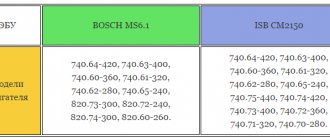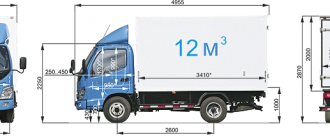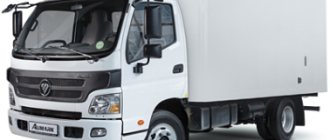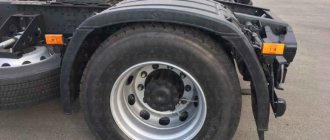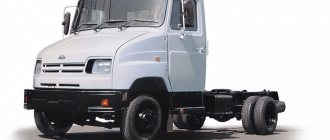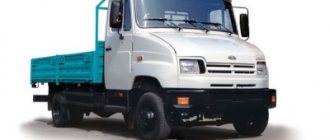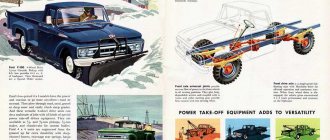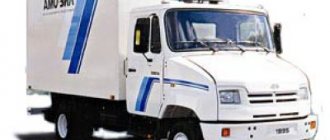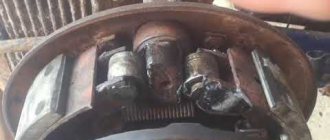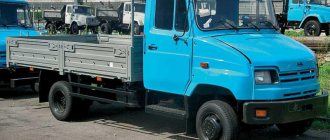On the ZIL-5301 car, which is already more than 10 years old, the bottom of the cabin needs to be welded in some places.
You need to install patches. The corners of the cab and the places where the cab is attached to the frame are especially susceptible.
Craftsmen came up with one good thing. We replaced the standard compressor with a compressor from a PAZ bus.
This removed the load from the fuel pump shaft.
Because during operation of the high-pressure fuel pump the bearing quickly fails.
To install the winch, you need to weld a frame from a channel or a corner of this type.
On the frame we install a shaft with bearings for the movement of the cable and guides for the cable.
Structurally, the gas pedal on the bull is very hard. The pedal is controlled by rods.
And after a long trip, the leg gets very tired. After thinking a little, I had to modify this unit.
On the ZIL-5301 the washer reservoir is inconveniently located. Inconveniences arise when refilling it. Passengers may also touch the pump and hoses. There was a need to remove the washer reservoir in the engine compartment.
The pre-heater produced in Tyumen has proven itself quite well.
There are car models that are almost impossible to operate without tuning. Unfortunately, Zilov’s Bychok is one of these cars. Its time passed twenty years ago and this is understandable, but due to the lack of cheap trucks, we have to use used bulls. By the way, whatever you call the boat, that’s how it will float. And now we are not talking about bulls, but about the index.
Tuning the Bychka index
The factory index of Bychka is ZIL 5301. If someone understands the classification of domestically produced trucks, then this index should say that we are dealing with a vehicle with a total weight of more than 10 tons (5th class), although in fact the total weight of Bychka is 7,500 kg. If we are guided by GOST standards, then the index of this truck should have started with a three, not a five, which corresponds to the total weight of the KamAZ.
And it was like this. In the mid-90s, just like now, finances were tight at the enterprise. Therefore, when developing a new small-tonnage truck, they used components and assemblies that were, and not those that should have been. It’s the same with the index - in order to assign an index to the truck, you had to pay for registration, but there was nothing to pay with. The factory got out of it and assigned Bychka an index that had previously been assigned to ZiL from a model that did not go onto the production line.
Car history
The Likhachev Automobile Plant had no experience in developing cars of the class with a carrying capacity of 3000 kilograms, so the company decided to use proven developments from Daimler-Benz AG.
As a result, in 1993, a prototype “Bull” was presented, the basis for which was the units and components of the Mercedes-Benz T2, which became the predecessor of the Mercedes Vario. Domestic engineers, having studied the design of the German product, redesigned it taking into account Russian realities, market opportunities, production and road conditions.
Mercedes-Benz T2
These factors affected the model in such a way that the ZIL-5301 could not be called a copy of the Mercedes-Benz T2. The car received an unusual name at the insistence of Moscow Mayor Yuri Luzhkov. In fact, if you look closely, you can really see the bull in the front of the car.
2 years later, large-scale production of the model began. The appearance of the car was vital for the company, since the demand for medium-duty trucks, in which it specialized, sharply decreased with the transition to a market economy.
Engine Description
The truck in question was equipped with several types of engines at different times:
- MMZ D-245.12S (Euro 0);
- MMZ D-245.9 E0 (Euro 0);
- MMZ D-245.9 E2 (Euro 2);
- MMZ D-245.9 E3 (Euro 3).
From April 2008 to the present day, all ZIL-5301 models are equipped with engines that meet Euro 3 requirements in terms of their environmental qualities.
Do you know thanks to which
technical characteristics of MAZ-53366
not only in demand among consumers, but also in production from 1978 to the present {q}
After reading this article, you will be convinced that buying a used Hovo dump truck in many cases is much more profitable than purchasing a new one.
The MMZ D-245.9 engine has the following characteristics:
- type – diesel, four-stroke;
- cooling – liquid (antifreeze);
- formation of the fuel mixture - direct injection;
- total number of cylinders – 4 pcs.;
- cylinder diameter – 110 mm;
- piston stroke length – 125 mm;
- total combustion chamber volume – 4.75 l;
- compression (calculated value) – 15.1;
- the maximum possible power at rated speed is 136 hp. With. (100 kW);
- crankshaft rotation speed – 2,400 rpm;
- fuel consumption – 215 g/kW;
- torque (maximum) – 460 N×m;
- weight – 430 kg (dry), 500 kg (with filling fluids).
The engine in question, among other things, is equipped with a turbocharger - this is one of the reasons for such high power. The design involves cooling the air before blowing (intermediate).
The overall dimensions of the motor are relatively small, despite years of development:
- length – 1,016 mm;
- height – 1,035 mm;
- width – 719 mm.
Consumption is approximately 12 liters for every 100 km at a speed of no more than 60 km/h.
“Bychok” is quite fast and can compete even with its foreign counterparts: the maximum speed with maximum load, according to the accompanying documentation, is 95 km/h.
The actual speed of this car is slightly higher. The ZIL-5301 accelerates to 60 km/h in 30 seconds.
Specifications
ZIL 5301 represents a line of light-duty trucks. But even in this segment it looks very compact.
Dimensions of the car:
- height – 2365 mm;
- length – 6195 mm;
- width – 2319 mm;
- wheelbase 3650 mm;
- front wheel track - 1832 mm;
- rear wheel track – 1690 mm.
Depending on the modification, the dimensions of the machine may differ slightly. Thus, the length of the ZIL 5301 TO is 7165 mm (almost 1000 mm longer than the base version).
Without cargo, the vehicle weighs 3695 kg, which makes it easy to overcome various utilities and obstacles. The total weight with the maximum permissible load is 6950 kg. The ground clearance of the 5301 model is small in comparison with Odnoklassniki and other ZIL products - 180 mm. It is not always enough to travel over rough terrain or rural roads. This is explained by the fact that “Bychok” is positioned as a small city truck. At the same time, the car feels good on narrow streets and in confined spaces. The turning radius of the model is 7800 mm.
Other characteristics of ZIL 5301:
- maximum speed – 95 km/h;
- acceleration time to 60 km/h – 30 seconds;
- average fuel consumption – 12 l/100 km;
- permissible load on the front axle – 2350 kg;
- permissible load on the rear axle – 4900 kg;
- load capacity – 3450 kg.
The car is equipped with tubeless tires with the following parameters – 6.5J at 16 and 225/75R16С.
Body
The ZIL-based dump truck has a powerful and strong frame designed for high dynamic loads. This is an advantage in terms of reliability of the modernized car.
Heavy and voluminous structures for various purposes can be installed on a solid base.
There are the following options for altering the car body:
- Cargo compartment. It is executed in the form of a stationary part combined with the body. Arches for an awning or a monolithic metal canopy are installed on the sides. The tailgate, similar to Ford pickups, tilts back. There is space for a spare wheel and a spare parts box.
- Passenger salon. Powerful safety arches are made. It is better to use a profile pipe with a cross section of 100x50 mm in a straight or arched form. Multilayer walls with foam inside are made or ready-made facade panels are taken. Car seats are screwed directly to the frame.
- Loader. A crane-manipulator is installed on the bottom. It is better to use a mechanism with a telescopic boom to increase the range of the lifting device. Such a vehicle can be used to perform loading and unloading operations, transporting large and heavy objects and materials.
- Change house. A ready-made or home-made booth made of timber or a steel frame covered with shields is installed on the platform. The cabin houses furniture necessary for camping life (bunks, tables, benches). To ensure vital functions in winter, a heating stove is installed. The bull is used for travel, hunting and fishing, and harvesting in the field and forest.
If necessary, the car body can be converted into a water carrier, tow truck, folding platform or coffee shop.
What can be changed?
Tuning a ZIL car (photos of which can be seen in this article) most often consists of the following steps:
- Frame reinforcement.
- Engine replacement.
- Interior improvements.
- Increased comfort.
This is a fairly general list of work performed. More specific methods depend on the desires and capabilities of the car owner. In addition, it is necessary to start from the truck model, which must undergo tuning. Let's take a closer look at three of them: ZIL-130, ZIL-131 and ZIL-5301.
Let's sum it up
The car had many advantages, which is why it was in great demand both from private carriers and from large companies. Over time, it was modernized, it became more environmentally friendly and easier to operate. If you compare the latest and first models, you can notice a significant difference in the quality of assembly and the operation of machine elements.
Considering the car’s considerable journey through changes and assembly line production, we can expect that in the future the model may acquire new data that will once again make the good old “Bull” one of the most popular light-duty vehicles.
We advise you to read the article: ZIL - the history of the auto giant
Welcome!
The website www.Zil-Bychok.ru is dedicated to the ZIL Bychok car.
Also other ZIL models: ZIL 130 ZIL 131 ZIL 133 ZIL 157 ZIL 4331.
Zyl bull photo, tuning, salon
The main reason for buying a truck is the opportunity to make money on it by transporting various goods. And for the income to be constant, the car must always be running.
This means you need to choose a reliable truck, but at an affordable price. If you don’t know anything about cars, then ask for advice from professionals or friends who know about this matter. And what do you hear? The only thing that fits your description, namely reliability and a reasonable price, is the ZIL “Bychok” truck.
Tuning zil bull:
Sadko gas is produced quite normally these days, the prices are almost the same, but for some reason Zil 4327 is not sold anywhere, moreover, some write on the internet that they have been discontinued from production for a long time.
At the same time, the advantages of Zil include a three-seater cabin, a higher seating position, and, in my opinion, it is more beautiful in appearance than Sadko. Naturally, the old “shishiga” is no longer an option to go 800 km somewhere for fishing in Karelia, and it is also gluttonous, but the options described above are D245.
And indeed, unlike foreign cars, “Bychok” is quite inexpensive, and in quality it is not inferior to them. But rumors are rumors, but still I would like to take a look at this ZIL “Bychok”.
Zil bull minibus
Troubleshooting ZIL 5301
Initially, this car was configured to overcome problems that it itself partially created. Lying under our feet was a diesel tractor D 245, which had served faithfully in the fields of our homeland since the times of Khrushchev. Engineers found a place for it under the hood of a new truck. The cabin was used from the older ZIL model, the gearbox was from the ZIL 130, and the disc brakes were from the government ZIL. This whole set had to be glued together into one mechanism and thoroughly tested, but the plant did not have time. Therefore, tuning the ZIL Bychok remains a natural test and modification of the car by the hands of the owners.
True, there was an attempt at factory tuning of the truck. This modification can still be found on the roads today - ZIL 53012, but, unfortunately, it is extremely rare. The essence of this modification is that the factory simply took the chassis from the Mercedes 709 D and put on it a cabin and an onboard platform from Bychok. In fact, this is the same used Mercedes, but skillfully stylized to match the unique design of the Zilov truck.
Price of new and used ZIL 131
The truck is one of the most affordable vehicles in its segment. In this regard, only Chinese models can compare with it.
The new ZIL 5301 cannot be purchased, since its production ended in 2014. However, there are still cars on sale without mileage, their cost depends on the modification. The price tag for basic versions starts from 774,776 rubles. Models with an extended platform will cost from 811,561 rubles. Models with a large platform will cost 796,450 rubles for the minimum version.
Used cars are offered cheaper. So, cars from 1996-2001 will cost 80,000-120,000 rubles. Newer options (2006-2008) will cost 220,000-300,000 rubles.
Renting "Bychka" is very popular. The cost of an hour of operation of ZIL 5301 will cost 450-600 rubles.
Upgrade level
Tuning may include a varying number of modifications performed. Depending on this, there are three degrees:
- Cosmetic - minor changes, which consist of installing additional elements (headlights, visor, moldings, radiator grille, guardrail, etc.), painting the body and its airbrushing, equipping it with a modern audio system.
- Medium - aimed at increasing the level of comfort in the cabin, improving the exhaust system, transmission and other individual parts of the engine.
- High - in addition to the work already described, the technical characteristics of the truck are improved (fuel consumption, power, handling, speed, etc.).
These modifications may apply to any of the models.
Tuning the ZIL Bychok cabin
The only advantage of this cabin, according to drivers, is its spaciousness and good visibility. After all, it's from a big truck. Compared to the Gazelle, it is very spacious and three people feel quite comfortable. If the cabin is double or with a sleeping bag, there are no special problems either. As a rule, drivers insulate the cabin, redo the heater, since the standard heater is good, even in winter it is not cold in the cabin with a sleeper, but they usually arrange the hot air ducts.
It is useless to fight vibrations and noise from a tractor engine. It's easier to change the motor. The sound insulation of the cabin helps, only partly. To do this you need:
- cover the inside of the hood with sound insulation;
- cover the engine shield on both sides;
- If possible, seal the holes for the pedals and levers.
The cabin will become quieter, but the vibration will not go away; it was the result of a very poor mounting of the supports on the frame, and the design of the cushions itself leaves much to be desired. This car is clearly not suitable for long-distance driving. Even with a sleeping bag.
Modifications
Cargo-passenger van ZIL-5301A3 specially designed for emergency services "
Mosvodokanal
»
- ZIL-5301 is the first production version with Mercedes-Benz units, a batch of 219 vehicles was produced in 1995.
- ZIL-530104 - chassis for fire trucks with a two-row cabin.
- ZIL-530120 - reanimobile.
- ZIL-5301AO - onboard, wheelbase 3650 mm. Produced in 1996-2001.
- ZIL-5301A1 - cargo and passenger van.
- ZIL-5301A2 - cargo and passenger van.
- ZIL-5301A3 - cargo and passenger van.
- ZIL-5301BO - chassis for vans, wheelbase 3650 mm. Produced in 1996-2001.
- ZIL-5301VA - chassis for vans, cabin with two berths, wheelbase 4250 mm.
- ZIL-5301VE - onboard.
- ZIL-5301V2 - chassis.
- ZIL-5301V3
- ZIL-5301V4
- ZIL-5301GA - chassis for special bodies, double-row cab, wheelbase 4250 mm.
- ZIL-5301GO - chassis for vans, wheelbase 3650 mm.
- ZIL-5301DO - chassis for vans, wheelbase 4250 mm.
- ZIL-5301EO - chassis for special bodies, wheelbase 4250 mm.
- ZIL-5301EE - onboard.
- ZIL-5301ES - all-metal van, wheelbase 4505 mm
- ZIL-5301E2 - chassis.
- ZIL-5301E3 - chassis.
- ZIL-5301E4
- ZIL-5301IO - chassis for vans, wheelbase 4250 mm.
- ZIL-5301KE - onboard, wheelbase 4250 mm, engine power 130 hp. With.
- ZIL-5301K2 - chassis.
- ZIL-5301K4
- ZIL-5301ME - airborne.
- ZIL-5301M2 - chassis.
- ZIL-5301NS - all-metal van, wheelbase 3245 mm.
- ZIL-5301PO - chassis for vans, wheelbase 3650 mm.
- ZIL-5301RO - chassis for vans, wheelbase 4250 mm.
- ZIL-5301R1 - all-metal van, wheelbase 3650 mm, engine power 130 hp. With.
- ZIL-5301SS - all-metal van, wheelbase 3650 mm, engine power 108 hp. With.
- ZIL-5301TO - flatbed with a two-row cabin, wheelbase 4250 mm.
- ZIL-5301FA
- ZIL-5301CHA - tow truck.
- ZIL-5301YUO - chassis for vans, cabin with two berths, wheelbase 4250 mm.
- ZIL-5301YAO - flatbed, cabin with two berths, wheelbase 4250 mm[3].
Model history and purpose
In the early 1990s, a project was opened at the Likhachev plant to create a new series of light-duty trucks. The designers used individual units and components from other products of the plant; the German Mercedes-Benz T2 truck with high headlights was used as a prototype for the new product.
The debut running copies of the ZIL 5301 appeared in 1994. There was no talk of mass production back then. The model received a cabin from ZIL 4331, some elements from Mercedes-Benz, an original hood shape and German OM364 turbodiesels (volume - 4 l, power - 115 hp). Initially, the development was called ZIL 3301M, but then the index was changed to ZIL 5301.
The plant produced a pilot batch in 1995, and 2 years later large-scale production of the model, nicknamed “Bull,” began. The appearance of the car was vital for the company, since the demand for medium-duty trucks, in which it specialized, sharply decreased with the transition to a market economy.
1997 also saw the introduction of a modular all-metal van body design, which made it possible to create multi-section vans (2, 3 or 4) with a total volume of up to 20.5 cubic meters. The basic version was the ZIL 5301SS with a 15.5 cc body.
Later, cargo-passenger variations of the ZIL 5301 appeared, the production of which was made possible thanks to the low loading height (765 mm) and a sliding side door. The cargo compartment of these models has been slightly reduced.
In 1998, the plant introduced several small buses based on the ZIL 5301 with a capacity of 15-19 people.
By the beginning of the 2000s, Bychok became the leader in the production volume of AMO ZIL with a 56 percent share. However, with the advent of Chinese analogues, demand for it began to fall rapidly. By 2008, ZIL 5301 had significantly passed (11.6% of the total volume). Even minor upgrades did not allow the situation to be corrected, since the build quality remained low.
In December 2011, the production of Bychka was moved from the capital to the Saratov region. This did not significantly affect the situation. ZIL 5301 was still inferior to its main competitors: European and Japanese analogues in terms of quality, and Chinese cars in terms of price. As a result, production of the truck ended in 2014. The release of the updated “Bull” is expected (photo below).
"Bull" was available in the following modifications:
- ZIL 5301AO – basic version;
- ZIL 5301BO – version for installing bodies and special superstructures;
- ZIL 5301GO – isothermal van;
- ZIL 5301PO - isothermal van with improved characteristics;
- ZIL 5301DO – extended variation;
- ZIL 5301EO – extended variation for installation of special bodies;
- ZIL 5301IO – isothermal van with an extended base;
- ZIL 5301TO – extended 2-cabin chassis based on ZIL 5301DO for installation of special bodies;
- ZIL 5301YUO – long-wheelbase version with 2 berths.
In terms of technical parameters, “Bychok” is not inferior to its competitors. A model was created to carry out transportation within a city or region. For long trips there were modifications with sleeping places.
Brake system
The car in question is equipped with a dual-circuit braking system. Each circuit is completely independent. One of them brakes the front right and rear left wheels.
The second is front left and rear right. Thus, maximum safety on the road is achieved: even if one of the system components fails, emergency braking remains quite possible.
The brakes are operated hydraulically. Air amplifier (pneumatic). There is also a handbrake; it is mechanically connected (with a steel cable) to the rear mechanisms. The brakes have the following design:
- front – disc type;
- rear - drum.
The latest models, released recently, are equipped with an anti-lock braking system (ABS).
Rear brakes ZIL 5301
The brake system of the ZIL-5301 has a dual-circuit braking system, each circuit operates independently of each other. Braking is carried out by contours, in particular using one front and rear wheel with a cross-over system.
Front disc brakes on ZIL Bychok
The ZIL Bychok has air brakes with a hydraulic drive. The air pressure in the pneumatic system must be at least 7.2 atmospheres.
Brake system ZIL 5301 Bychok, diagram
The ZIL5301 air system increases vehicle safety in emergency situations. The brake design combines front disc and rear drum. In later ZIL Bychok models, the brake system has an anti-lock wheel device, which also increases the safety of the vehicle.
Device
The prototype of the car was the Mercedes Vario. The design of the ladder-type frame with channel-section side members was borrowed from its German “brother.” This made the “bull” as safe as possible (even in a head-on collision, the car frame did not fold). There is a special device at the front for towing the car.
The brake system is 2-circuit, each circuit is independent. The first circuit brakes the left rear and right front wheels, the second - the other two wheels. This ensures road safety. In case of problems with one of the circuits, the driver can perform emergency braking. The brakes are operated hydraulically. Front brakes are disc, rear brakes are drum. The car is also equipped with a standard mechanical handbrake. The latest versions of ZIL 5301 are equipped with ABS.
The ZIL 5301 uses a 5-speed manual transmission with a hypoid main gear. The clutch is a standard disc clutch in an oil bath. In all gears except first and third, the synchronizer works. The main transmission mechanism is a cardan transmission with 3 joints and an intermediate support.
The base model is equipped with standard stamped discs made of high-strength metal. The alloy is characterized by great hardness, allowing it to withstand extreme loads without losing shape. Their use on this truck is absolutely justified. Along with the wheels, classic tubeless tires 227/75R16C are used. When unloaded, the impact of the axles on the road surface is approximately equal.
The cabin and interior of the car are very comfortable, although most of the elements have an unpretentious appearance. The driver's seat is adjustable in several ways and is very soft. Its casing is made of durable material. The cabin has good sound and heat insulation, allowing you to move comfortably in winter (a powerful stove heats the interior well even in cold weather). ZIL 5301 models are equipped with power steering, which simplifies maneuvering. In addition to standard cabs, extended versions with a sleeper and a hatch are available.
Thanks to the simplicity and reliability of the design, “Bychok” has become very popular among Russians. Most car components can be repaired even on the road. However, the model also has serious drawbacks.
Among the main disadvantages are:
- poor paintwork. Peeling of paint on the cabin begins within the first year of operation (especially on older models). Most used cars have traces of corrosion.
- noisy unit. Even at idle, the engine makes a strong rumbling sound. The problem can be eliminated by additional sound insulation using felt or other material;
- unreliable autonomous heating system (installed additionally);
- If there is a sunroof, leaks are often observed;
- Difficulty starting in winter. The problem is relevant for all modifications of ZIL 5301;
- when working for a long time with overload, the rubber often breaks;
- the rear axle has defects in the differential gears and cracking of the crosspieces;
- The car is sensitive to low-quality fuels and lubricants.
At the same time, proper maintenance can significantly extend the performance of the car. The engine oil must be changed after 10,000 km, and the gearbox oil must be changed after 30,000 km.
At the same time, spare parts for the ZIL 5301 are cheap, and its repair does not cause any particular difficulties.
Electrical diagram of ZIL 5301
Tuning the ZIL 5301 engine
The tractor engine itself is, of course, a reliable thing, but installing it on a truck is a very controversial step. The fact is that this engine has a torque of 384 Nm at a frequency of 1400 rpm, which is, in principle, normal for a tractor. But not for a truck. On Bychka it is almost impossible to start from second gear, as in one hundred and thirty, you can, but the clutch won’t last long. The engine doesn't pull at low speeds, so you have to take off from first like a car. And the power of 105 horses is not enough for a working machine.
In principle, if you approach any technology humanly and with an understanding of the process, then it will serve for a long time. The main thing is to know Bull's weak points. Drivers most often complain about the front brakes being short-lived, constant problems with the wiring, noise and vibrations in the cabin, the king pins in the front axle are short-lived, and there are also problems with the life of the clutch. In a word, the ZIL 5301 is a car for last resort, but if it is well-groomed, lubricated and serviced, the likelihood of a breakdown 20-30 thousand km in advance is eliminated.
